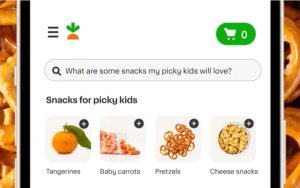
Image courtesy of Branding Strategy Insider
What’s the attention economy, you ask?
Well, everything is in short supply, which gives it value — money, raw materials, labor, products, even time. In economics, we talk about why diamonds, which may be a girl’s best friend, but aren’t essential for human life, costs more than water, which is. The answer is supply — diamonds are rare, while water is freely available in most places.
And, today, in a society where content is a mere click away, attention is the new commodity in short supply.
You may already see the effects of the attention economy on your business:
- Have you noticed it’s a lot harder to drive traffic to your website?
- Do your online ads get fewer clicks than before? [the average CTR for banner ads is a measly .08%]
- Has your email open rate plummeted? [various sources put this at around 20% open and 3% CTR]
If you’re like most online advertisers, the answer to all these questions is YES. And, that’s a direct result of pressures in the attention economy.
In today’s world, where we’re “always on”, there’s unprecedented access to information, entertainment, and distraction that result in efforts to attract what may be the most limited resources of all: attention.
As the infographic below shows, consumers are inundated with advertising, but also with cat videos, updates from celebrities they follow, fake news, photos, emails, and a myriad of other sources all vying for their attention.
Simply put, the attention economy reflects the reality that there’s more noise online than ever before; making it harder to reach your target audience and get them to take action. It’s even hard to reach folks in the real world, as you can see from the image above. Instead of focusing on the runway model showing off this year’s hottest clothing, folks are glued to their phones, live Tweeting the event (you hope), or texting a friend a link to the new meme they discovered on Instagram (more likely).
Today, we’ll talk about how to survive, even thrive, in the attention economy.
Limitations on attention
It’s a myth that humans, any human, can multi-task. Here’s what Inc wrote recently about the myth of multitasking:
MIT neuroscientist Earl Miller notes that our brains are “not wired to multitask well… when people think they’re multitasking, they’re actually just switching from one task to another very rapidly. And every time they do, there’s a cognitive cost.”
This constant task-switching encourages bad brain habits. When we complete a tiny task (sending an email, answering a text message, posting a tweet), we are hit with a dollop of dopamine, our reward hormone. Our brains love that dopamine, and so we’re encouraged to keep switching between small mini-tasks that give us instant gratification.
This creates a dangerous feedback loop that makes us feel like we’re accomplishing a ton, when we’re really not doing much at all (or at least nothing requiring much critical thinking). In fact, some even refer to email/Twitter/Facebook-checking as a neural addiction.
In a world where information is everywhere, we fall into the dangerous trap of trying to see everything and, instead, not seeing anything … not seeing the most important things, at least. So, the question becomes not paying attention, but learning to pay attention to the right things.
According to the infographic, the average attention span is only 8.25 seconds — down from 12 seconds in 2000, which is another indication that the attention economy is becoming even more limited.
Surviving the attention economy
First, let’s talk about attention for a moment, specifically selective attention. Selective attention is likely a survival mechanism, allowing us to pay attention to those things that most likely impact our survival.
Tip #1: Make a big noise
Because of its role in survival, sound has a big impact on attention — hearing a predator coming was important for surviving an attack to our ancestors, for instance, just as hearing an approaching car is important for survival today. Hence, the reason cars have horns.
In traditional advertising, marketers often compressed the sound to make commercials seem louder than the programming surrounding it. In today’s world, where consumers increasingly skip advertising — using streaming, for instance, to eliminate or skip through advertising or ad blockers on mobile devices — that tactic doesn’t work. Instead, making bold statements that disrupt the status quo makes a big noise by encouraging amplification (massive sharing or virality).
You don’t have to look further than the recent US presidential election to see how a big noise affects behavior. Rather than using calm reasoning, Trump shouted shocking things that made him a fixture on the nightly news and online new sources.
Tip #2: Create value
OK, so creating value a couple of times isn’t going to work in the attention economy.
But, creating value over time certainly brings you to the top of the list for your target audience. Create value, true value to your audience and the word gets around pretty fast — especially if you do tip #3 right (no peeking).
This blog is a good example of that principle in action — if you don’t mind a little bragging here. My blog is now syndicated on news sites, including Yahoo Business and NewsCred, as well as Business 2 Community, strictly based on the value I provide readers. In a very crowded space, I’ve broken through to compete with much larger teams with a lot better funding than I have. In fact, I’m being interviewed on NPR Marketplace this week and last week I appeared on a program with folks from the biggest tech companies in the world.
In addition:
Chunk your content to make it ease to skim and find the nuggets of value by using headings and subheadings, lists, and bolding statements containing key takeaways.
Avoid promotion, at least keep it down to 80% value to 20% self-promotion.
Don’t use pop-ups that cover your content. I see this happening so often lately. You get to a page containing an article you want to read. Instantly, a popup hides the content with an ad or offer to join the mailing list. With only 8 seconds to attract attention, you’ve just shot yourself in the foot. And, annoyed your visitor.
So, create content that provides value, don’t mess it up with a ton of promotional crap, and make your content easy to digest.
Tip #3: Make content easy to find
Don’t hide your great content under a rock. Spread it far and wide.
For most sites, that means doing great SEO because search sends the most traffic to your site. And, today, SEO means content. So, tips 2 and 3 support each other.
There are lots of other tools for making your content easy to find.
- reach out to influencers with content
- build that mailing list and share unique content to subscribers
- use social engagement to build social networks where you can share your content
- share content on other high-authority sites
Image courtesy of Social Media Today
Business & Finance Articles on Business 2 Community(30)








